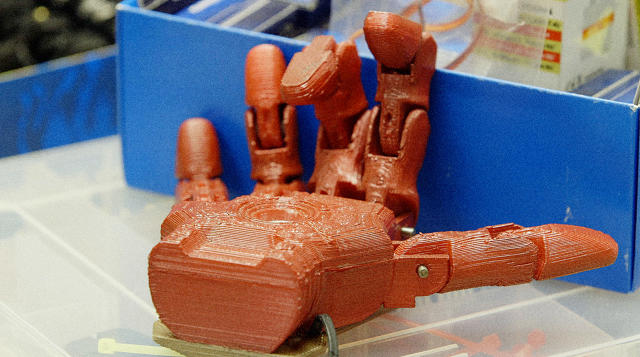Wearable technology only matters when it does good in the world. Open Bionics is doing just that. The company is building 3-D scanned, 3-D printed prosthetics—wearable robotic hands for amputees. Its goal is to make wearables more functional and affordable than what’s currently on the market. It's not the only ones working on the problem. The hard part is: how do you engineer better prosthetic hands?
A first step: start with a genuine desire to help.
"There are amazing prosthetics. But fitting can take up to 12 weeks and cost $100,000 [over a child’s lifetime.] We can make this for $2,000. With 3-D scanning, we can get a scan in two minutes and 3-D print a custom-fitted socked in two days," says Open Bionics Community Manager Samantha Payne.

"The reason we’re doing this is for children like Alfie." Alfie is a three-year-old who was born without a right hand. Four days before the presentation, the Open Bionics team got a message from Alfie's mom saysing that "he really wanted us to 3-D print him a bionic Power Ranger hand. He asked Santa for it to be his Christmas present. It would make him feel like a superhero. That’s what we want to do."
"The reason it’s stylized like a superhero," founder Joel Gibbard explains, "is because a child can really relate to that. If they can put this on, it’s not something that they want to hide or that they’re ashamed of at all."
But it’s not easy to make a new type of prosthetic. The first challenge Gibbard and his team ran into was how to make a hand that’s lightweight enough. With prosthetics, weight matters.
"Materials are a problem," Payne says. "At the moment the hand weighs the same as the leading bionic hands, but that’s still not good enough. Amputees won’t want to wear it. They’ll take it off because it’s too heavy. 3-D printing allows these to be lightweight, but that’s still not good enough. It’s a challenge that we’re going through."
The other engineering challenge came with an excellent lesson: simple is often better. "The other challenge that we faced: we felt that amputees wanted loads of functionality. We were focused on making the hand super dexterous. It could do so much. But they want less tech in the hand. They just want open and close and for it to be really light."
They also learned by building a fully-working prototype of a dexterous, robotic, prosthetic hand. This adult-sized hand connects with wires to the EMG signals of the muscles. It can close and open. It can grip different types of objects and objects of different shapes. And it can use a finger and thumb to tightly hold onto small, light objects like a cell phone—or perhaps a Lego block.
"A lot of people have been asking how strong the hand is. You can tell it’s strong enough to hold all sorts of different objects," says Gibbard. "If I tell it to close again, the grip will get stronger and stronger. It gets a very firm grip."

For Gibbard, this project started as a university project. It became a labor of love, as evidenced by the fact that he quit his job to do it. "Joel was at university and he developed this hand. Then he got a really nice, well-paid job but he felt guilty knowing he knew the solution to this problem having done loads of research. He knew the market. He knew how desperate amputees were for a solution, and he felt bad knowing that he could probably help change so many people’s lives. So he quit his job as an engineer. He sunk all his savings into it. And now it’s here," says Payne.
Gibbard and his team open sourced the IP, making it clear that business is important—but getting this out to people matters more. That was enough to catch the interest of Intel’s, which just awarded them $200,000 in the company's "Make It Wearable" competition. According to CEO Brian Krzanich, "With the Open Bionics hand, one of the things that was really valuable to me personally is that they did all of their work open source. The hardware and the software was all open. They weren’t in this either to make money necessarily. They were in it to change the landscape. To me, that was of huge value on their proposition."
There is demand for this type of product. And other engineers have been entering the space at the same time as Gibbard. Some with, arguably, more sophisticated designs, built to accommodate micro-controllers, wireless devices, smart watches, sensors, accelerometers, NFC, Bluetooth LE, and RFID. But Open Robotics is counting on their years of user testing—including a year and a half of talking with consumers, and a Twitter feed of global amputee feedback—to stay ahead of the game.
"We’ve been doing this for a year and a half, since a crowd funding campaign. We’ve got loads of amputees all over the world telling us why they hate their hand prosthetics," says Payne. "Leg prosthetics are really advanced. They’re beautiful. They’re fashionable. They’re stylish. Why are hand prosthetics so far in the past?"
The above story is based on http://www.fastcoexist.com/3038646/these-superhero-themed-3-d-printed-robotic-hands-show-the-future-of-prosthetics
Note: Materials may be edited for content and length.
Copyright © 2024 International Society of Bionic Engineering All Rights Reserved
吉ICP备11002416号-1









